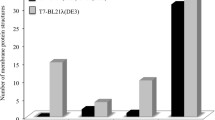Abstract.
The phospholipid and fatty acid content of the Escherichia coli membrane were investigated during continuous cultivation. At low growth rates, there was an increase in cardiolipin produced at the expense of phosphatidylethanolamine. Phosphatidylglycerol had a maximum at a growth rate of 0.3 h–1. The amount of cyclic fatty acids was markedly increased at lower growth rates, while there was an evident minimum at 0.3 h–1. This was also the case for saturated fatty acids. At this point, the unsaturated fatty acids had a maximum depending mainly on changes in cis-vaccenic acid. The mechanical strength towards sonication and osmotic shock/enzymatic treatment showed that the cells were more rigid at low dilution rates. However, this was accompanied by a higher cell lysis, a reduced capacity for total and specific protein production and a lower yield of cells. The amount of lipid A in the medium (endotoxin) was constant and negligible at all growth rates. The leakage of periplasmic protein to the medium had an optimum at 0.3 h–1, resulting in a transport of 20% of the total recombinant product. It is argued that this constitutes the point of highest membrane fluidity and thus an increase possibility for protein transport.
Similar content being viewed by others
Author information
Authors and Affiliations
Additional information
Electronic Publication
Rights and permissions
About this article
Cite this article
Shokri, .A., Sandén, .A. & Larsson, .G. Growth rate-dependent changes in Escherichia coli membrane structure and protein leakage. Appl Microbiol Biotechnol 58, 386–392 (2002). https://doi.org/10.1007/s00253-001-0889-0
Received:
Revised:
Accepted:
Issue Date:
DOI: https://doi.org/10.1007/s00253-001-0889-0




